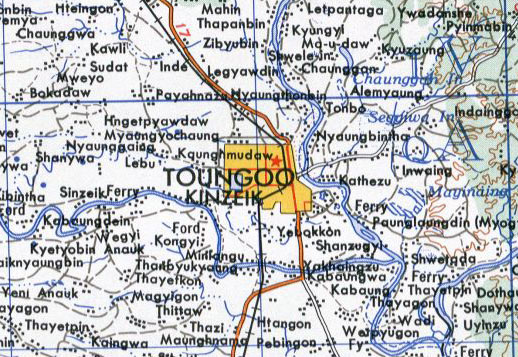
Outflanking Toungoo
29/3/42
On March 8, 1942, advanced elements of the 200th Division arrived at Toungoo on the same day Rangoon fell. The Chinese took over the defence of this key location from a small detachment of British forces. Toungoo controlled the road north toward Mandalay and the bridge over the Sittang River that carried the road east to the Karenni States and north to Loikaw, the Shan States, Lashio and the Chinese province of Yunan. Capture of the city could threaten the flank of the Allied defensive line in Burma and open the way to a Japanese advance into Central Burma.
Ten days later on March 18 the first skirmish with the leading elements of the Japanese 55th Division, began on the Kan River. Falling back over the next three days, the Chinese cavalry delayed the Japanese advance while the Chinese completed their defences at Oktwin and Toungoo. When the Japanese attacked Oktwin they were held for another two days by determined Chinese resistance. Finally at 0800, on March 25 the Japanese launched an all out attack on all three sides Toungoo, this had limited success but the Chinese held out. They were still clinging to the city three days later.
On March 28th the Reconnaissance Regiment of the Japanese 56th Division, consisting of two motorized infantry companies and a machine gun company, a field artillery company of mountain guns, and a platoon of engineers, was moved rapidly north from Rangoon it made rapid progress along the main road to Toungoo and reached divisional HQ of the 55th Division by noon on March 28. It was decided to move this force east of the Sittang River to attack the rear of the Chinese positions. Crossing at 2000 the same day, it forded the Sittang at Wagyi, a few kilometres south of the city where the water was only chest high.
On March 29, the 55th Division used its last strength to attack, supported by all available guns. The Reconnaissance Regiment of the 56th Division moved north and attacked the Chinese flank guard east of the river threatening the divisional HQ of the 200th Division and the Sittang River bridge.
Abridged from: http://en.wikipedia.org/wiki/Battle_of_Toungoo
This scenario depicts the flanking attack of the 56th Divisional Recce Regiment against the Chinese flank guard to the west of Toungoo

US Army 1:250K Map of Toungoo
Map and Order of Battle
Chinese Deployment
The 3rd Battalion 599th Regiment is deployed on table in the area delineated by the dashed pink lines. All stands are entrenched (-3 cover)
The DHQ, HQ Company and Special Service Company are deployed within 3" of the 4 BUAs of Nyaungbintha. All stands are entrenched (-3 cover)
The 3rd Battalion 598th Regiment is a reinforcement entering within 12" of point A on turn 7
Japanese Deployment
The 56th Recce Regiment enters the table turn 1 between points C & D
Terrain
The map is 4ft x 5ft if playing 1" = 50m
For the most part the terrain is very open farmland with no cover
The thick blue line is a river. The water level is low and personnel (not manhandled or man ported guns) can cross using 2xBMA. It takes a BMA to enter the river The banks provide -2 cover for non H class fire crossing the bank as long as the firer is not in the river, touching the bank or touching a ridge line emanating from point 150.
The thin blue line is a small stream and the sandy line is a dry steam bed. In game terms they both give +2 cover to stands within. Manhandled (but not man ported) guns take a BMA to cross other stands are unimpeded
The brown dotted lines are ridgelines. they break LOS. If the Type 94 touches the ridgeline it gets a hull down bonus.
The green dotted lines are tree lines. They give +1 cover and break LOS except to or from stands touching the tree line.
The red lines are roads
The grey squares are wooden BUAs surrounded by trees. Personnel within get +2 cover. Vehicles and towed guns with get +1. there are no ROF penalties.
Special Rules
The game is 11 or 12 turn long. At the end of turn 11 roll d10 on a 6+ there is a further turn
As the Japanese have left all their vehicles behind all the guns are man ported. they can be carried at normal infantry speeds buy take an entire turn to set up or take down (ie "unlimber" and "limber")
Victory Conditions
Victory is measured at the end of the game.
If the Japanese have the most stands in good morale within 12" of point 150 the game is a draw.
If the Japanese have the most stands in good morale within 12" of point A the game is a Japanese victory (this trumps the "draw" condition)
If the Japanese achieve neither of the above the game is a Chinese victory.
Good morale means neither shaken nor demoralised.
References
The scenario was taken from postings on the Axis History Forum: